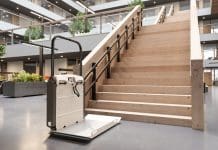Ian Streets, managing director of About Access, highlights the need to ensure accessibility in the changing post-Covid office environment
After a year of being bombarded by the numbers behind Covid, it’s now time for the awful anniversaries. But rather than dwell on such dates as the first diagnosis of Covid patients in the UK, it’s perhaps more worthwhile to look at when key measures were taken, and how businesses handled them.
The Prime Minister urged people on 16 March to work from home if possible and to avoid pubs and clubs. On 20 March, he instructed the hospitality and leisure sectors to close, and on 23 March he announced a complete UK lockdown effective from 26 March.
Adjusting to the ‘new norm’
Businesses dealt with the new regulations as best they could. Some had more freedom than others, but most were still confused about what they could and couldn’t do. Essentially, whether they realised it or not, businesses pretty much got used to the idea of making “reasonable adjustments” to look after their workers and customers.
There may be questions about the ease with which some people agreed to give up personal freedoms and about their willingness to overlook the negative impact that was experienced by many disabled people. We’ve written elsewhere about accessible parking bays being suspended to leave more space for queues outside supermarkets, about see-through face masks to help people who have to lip-read and about the need for greater awareness to help visually impaired people negotiate impromptu one-way systems.
The clamour for access to shops, pubs and restaurants ensured those environments were never far from the headlines. Public transport was also in the news, usually because passenger numbers went through the floor as more people worked from home – and found they quite liked it.
As the government’s restrictions shut down one business sector after another, the mood changed. Businesses that expected to spend much of 2020 preparing for Brexit instead found themselves dealing with the here and now of a workforce that was suddenly in many different places.
Even those who made full use of furlough were asking themselves how to go about bringing people back and there is a growing trend to not bother. That’s in part because some businesses reached the end of the line but it’s also because many employers found that homeworking works fine.
They spent heavily to provide the connectivity which gives people instant contact with office systems and their network of colleagues. Achieving a return on that investment means examining other overheads, and one option is to take a fresh look at property.
A new age of remote working may see people split their time between a desk at home and occasional visits to the head office, or even a new, smaller, regional office.
We considered at this in one of our consultations with the Home Office, which was looking to reduce the amount of floorspace they used because more people were going to be working from home, would no longer need dedicated desks and would therefore move to a hot-desk system. The fact that we were brought in demonstrates the awareness within the Home Office that accessibility applies wherever your people are working.
Hot desking
Hot desking brings its own challenges because some people want consistency in terms of where they are sitting and the chair and other equipment that they are going to use.
One worker who was part of the consultation told us she is visually impaired and has an assistance dog. It can create distractions for her if she sits in a busy area and people keep coming over to talk to her dog, so she likes to sit in a corner out of the way.
We are also aware of someone who works in an office and has a hearing impairment. They prefer their desk to back on to a wall because it reduces the likelihood of someone approaching from the side or from behind, when they can be startled and have difficulties communicating.
You might also find that in a smaller layout, shared facilities such as copiers and water coolers will be placed at the end of a cluster of desks. This again can create distractions for people who work in that area and it can also narrow the circulation route.
There was a suggestion that if someone needs a specialist chair, they can decide whether it should be located at home or at work, but ideally there should be two chairs because it’s unlikely to be easy to move one chair between two work places.
Another key point is companionship. Businesses and other organisations have come up with all sorts of innovative solutions to keep colleagues in touch professionally and socially, using Zoom and equivalents for work meetings and for social events.
It’s important to ensure people have that physical interaction as they return to work both for the health and wellbeing benefits and to provide other support. A personal emergency evacuation plan matches a disabled worker with a buddy who will help if the need arises to leave the building quickly. It’s essential that both workers are in the same group for returning to work and for another buddy to be assigned if necessary.
Ian Streets
Managing director
Tel: +44 (0)1482 651101
Please note: this is a commercial profile.














